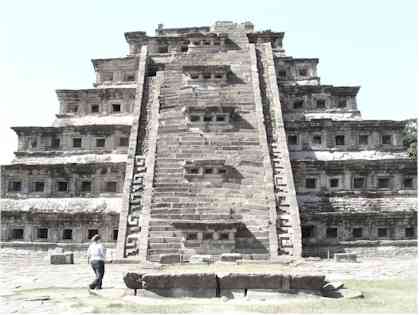
El Tajin
El Tajin is located in northern part of the State of Veracruz near the city of Poza Rica. It was built around 100 AD and was abandoned for reasons unknown about 1200 AD. No one knows for sure who built it or who lived there. The name "El Tajin" comes from the Totonac Indians who moved in later. The name refers to 12 old men who were supposed to live in the ruins and control thunder storms.

This is the Pyramid of the Niches. It is a classic step pyramid, but it has 365 niches along its faces, apparently one for each day of the year. The El Tajin people may have placed offerings in each day's niche as it passed, and the structure probably served as a giant calendar for the common folks.
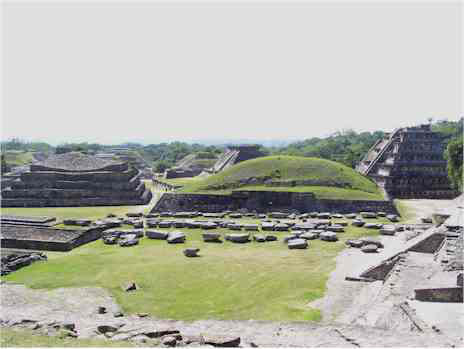
This is an overview showing only a part of the ruins uncovered so far. The Pyramid of the Niches is on the far right. At the lower left edge of the picture is part of one of the 17 ball fields identified so far. It is a long, narrow field between low walls and what might have been bleachers for the spectators. Obviously the game was popular with 17 fields in one city.
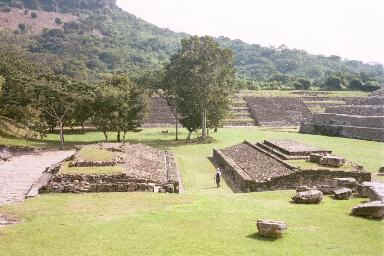
Here is a better view of the ball field. No one knows how the game was played or how points were scored. According to some murals found here, the players wore a stone yoke across their shoulders and a wide belt around their waist. The belt contained several long, narrow stone tablets. The armor was apparently needed since one of the murals shows a player being held by his opponents and stabbed in the chest with a stone knife. Obviously there was no "unnecessary roughness" penalty.
|
This is a model of what the city looked like in its prime, about 900 AD. The major parts of life in the city were apparently religion, ball games, and drinking alcoholic beverages. Not much has changed even to the present day, has it? |
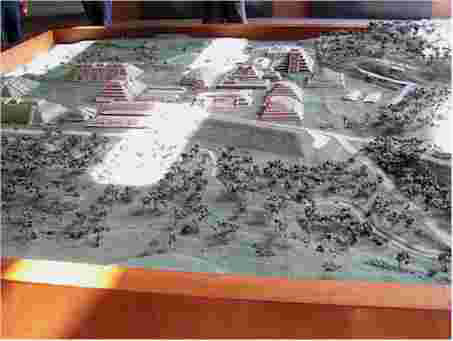 |
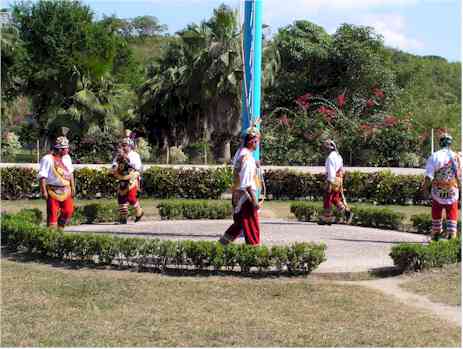 |
While we were visiting El Tajin, these performers called Voladores (flyers) put on an interesting show. A Totonaca myth tells of a time when there was a great drought, and food and water grew scarce throughout the land. Five young men decided that they must send a message to Xipe Totec, God of fertility so that the rains would return and nurture the soil, and their crops would again flourish. This performance was the modern version of that first, mythical dance. |
|
The five men climb the 75 foot pole. There is no safety harness or net. When this picture was taken, the fifth voladore was still on the ground collecting donations from the audience. The Voladores are Totonac Indians. This is their way to keep a part of their culture alive and also to earn a few bucks on the side. |
 |
 |
Here the Voladores arrange themselves on top of the pole; one to each side and one on the top of the pole in the center. The top of the pole is no more than 24 inches in diameter. The center one is the flute and drum player. He plays and dances standing on that pole for the few minutes the others need to get ready. They are attaching a rope to their waist. The rest of the rope is wound around the top of the pole. By the way, the last Voladore is on his way up now having collected all the money the audience was willing to part with. |
|
The four flyers start down now. The rope is tied around each flyer's waist. He then hooks his foot through the rope so that he is upside down. |
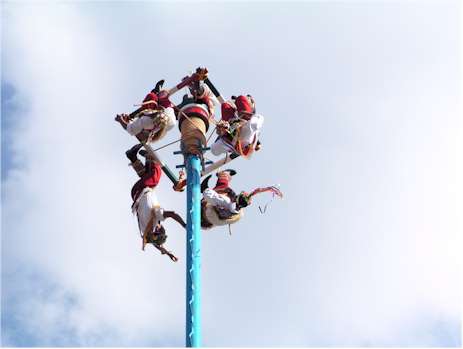 |
 |
Since the rope is unwinding from the pole, each flyer spins around the pole as he descends. The flute player is still playing and dancing.
|
|
Do you think his eyes are closed in meditation or terror? |
 |
Voladores perform all over Mexico and Central America. It is well worth your time if you get a chance to see a performance.